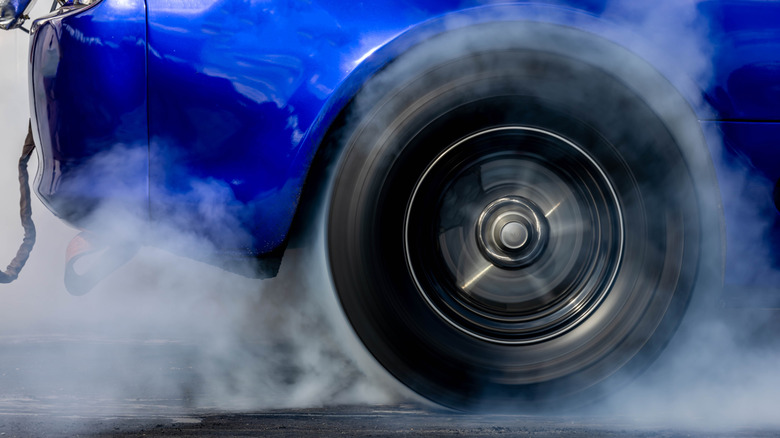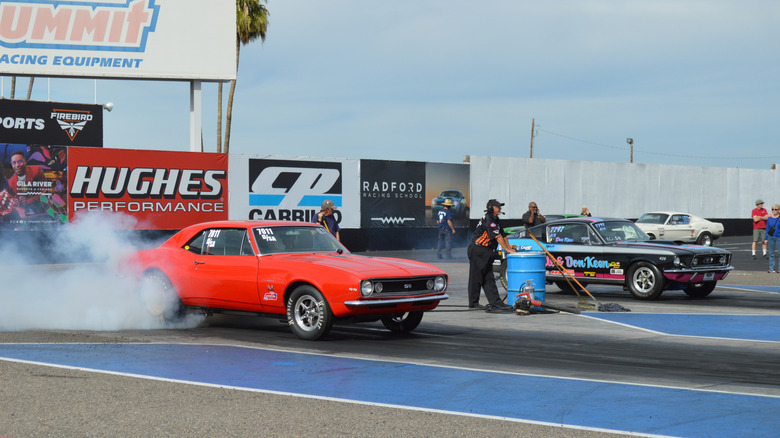Why Do Dragsters Do Burnouts? Here's Why They're Useful
Drag racing is a deceptively nuanced sport, with many factors influencing the perfect run beyond just which car has the most power. Even more important than power is traction — after all, a car spinning its wheels in place isn't accelerating as quickly as an equally powerful one that nails the launch. Suppose it's your first time going to a drag race, and you see the cars line up and do burnouts for no obvious reason. Are they intimidating their opponents and giving the fans a treat, or does this tactic have a legitimate racing purpose? Burnouts are all about improving traction and do this in two ways: by warming and softening the tires, and smoothing the track surface with a fresh layer of hot rubber. Both results help improve grip at the launch of a drag race.
While drag strips are already quite sticky thanks to all the preparation that goes into them, every little bit counts when the difference between a win and loss can come down to thousandths of a second. As such, the idea is to make the track and the car's tires as grippy as possible. Any significant wheelspin off the line can put a drag racer in an unrecoverable deficit. That's the fundamental principle behind why burnouts are so important, but what are the mechanics behind this? Why are cold tires less grippy, and how does laying fresh rubber on a drag strip improve traction?
The advantage of warm tires
In racing, you need the tires to be at a specific temperature to provide optimal grip. That's why Formula 1 cars swerve on the track during a safety car, why F1 tires have no treads, and why mechanics cover tires with heated blankets while they sit in the garage. The whole idea is to minimize the time spent on cold tires. If you look at a road or track surface up close, you'll notice it's anything but flat, with many ruts, small protrusions, and other imperfections. Rubber is a pliable material; it readily deforms as it heats up, working its way into this uneven surface more easily when it's warm.
Conversely, cooler tires are stiffer and more resistant to this effect. They glide more readily over asphalt and cement because there's less rubber being pressed into these imperfections, so you get less friction with the road surface. You also don't want overheated tires, because the rubber comes apart at high temperatures. The tire may even partially melt if it's hot enough, losing its structural integrity. So there's a "sweet spot" where the tire provides the most amount of grip — what temperature that is exactly depends on the rubber compound. Drag racers don't have the luxury of warming their tires up over a formation lap or by taking it easy for a couple of minutes. Rather, they need the tires warmed quickly on the car, and that's what a burnout does. They're done right before the launch to minimize the amount of time the tires have to cool down before the race begins for real.
Preparing the track surface
Drag strips feel sticky to the touch, differing from traditional asphalt in the way they're paved and prepped for racing use. The basic idea is to provide the best possible surface for the tires to grip onto. This not only provides the cars with better forward launches, but too much lateral slip poses a safety issue when you have cars flying down the track at hundreds of miles an hour. The tracks are also coated with fresh traction compound resin, providing the surface with that sticky quality. Burnouts not only heat the tires, but the resin and asphalt on the track surface as well. Temperature changes boost the grip levels afforded to the car and the track alike, and laying fresh rubber down provides a nice, hot, sticky surface for the car to launch from.
This proved far more useful back before the days of modern resins like PJ1 TrackBite, when cars would do back-and-forth burnouts while marshals laid powdered resins on the track for optimal grip. The basic pre-staging burnout ceremony is still observed, as anyone who lives near an active drag strip already knows. But its primary function is now to preheat the tires more than to provide a sticky surface for the circuit. Still, as rubber gets laid down and the track develops a consistent glossy sheen, the grip will subtly but steadily improve. Normally this change wouldn't be noticeable to the eye, but a stopwatch knows the difference.


